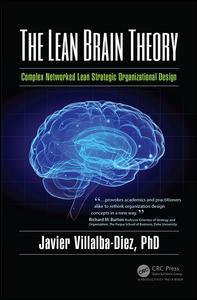The Lean Brain Theory Complex Networked Lean Strategic Organizational Design
Auteur : Villalba-Diez, PhD Javier

The most complex organization known in the universe is inside of our heads: our brain. Because organizations are formed by human beings, The Lean Brain Theory aims to mimic human brain structure and functionality so as to enable the emergence of brain-like organizations in which the 'neurons' are the human-beings and the 'axons' ought to be Lean Management oriented behavioral and communication patterns. These networks ought to evolve towards brain-like configurations that display thinking-like processes and ultimately organizational consciousness. The Lean Brain Theory offers a quantifiable holistic framework to strategically design any organization as a human brain. By embedding complexity into the Strategic Organizational Design (SOD) and combining this with Lean Management and neuropsychological state of the art knowledge, The Lean Brain Theory ends up with the Brain-Organization metaphor and makes it possible.
This idea of embedding complexity into organizational design is a follow up to the book The Hoshin Kanri Forest. That book dealt with the methodology of creating 'forest-like' topologies. The Lean Brain Theory aims to set the ground for Lean organizations of the future that embrace both Business Intelligence and Complex Networked Lean Strategic Organizational Design. The organization as a super-network evolves towards 'intelligent' Human-Brain-like entity. The Lean Brain Theory ultimately seeks to integrate an anthropomorphic organizational paradigm with future tendencies of technological advances. In this way, the brain-like organization emerging from it can be regarded as bionic.
Introduction.
Part 1. THE METAPHOR.
Chaper 1. Brain-Organizational paradigm.
Part 2. THE METHOD.
Chapter 2.The emergence.
Chapter 3. The rise of the Lean Brain.
Part 3. THE THEORY.
Chapter 4. The Lean Brain Theory.
Chapter 5. Perspectives on Organizational Culture
Part 4. APPLICATIONS.
Chapter 6. Interpersonal Power and the Lean Brain.
Chapter 7. Closing Reflections.
HAGAKURE 葉隠
Appendix. H4 Art.
References
Javier Villalba-Diez, PhD. is currently director and founder of an international consulting company that has the mission of empowering organizations achieve their strategic goals while increasing trust. Dr. Villalba-Diez is a Mechanical Engineer with Technische Universität München, Germany and Industrial Engineer with Technical University Madrid, Spain (2003) He received his PhD in Engineering, Economics and Organizational Innovation from the Technical University Madrid in 2016. His current research interests include Hoshin Kanri and Business Intelligence. He has a background of more than 15 years as lean consultant and several years as production manager in a number of positions related to manufacturing operations in German, American and Japanese manufacturing facilities. His research and work has brought him to numerous companies and hundreds of factories, where he collaborates with people to test ideas and share lessons learned. He splits his time between Spain, Germany, USA, and Japan. He is also the author of The Hoshin Kanri Forest: Lean Strategic Organizational Design.
Date de parution : 11-2017
15.6x23.4 cm
Thèmes de The Lean Brain Theory :
Mots-clés :
Complex Networked Organizational Design Configuration; organizational; Complex Networked Lean Strategic Organizational; design; Networked Lean Strategic Organizational Design; Organizational Design Configuration; HOSHIN KANRI FOREST; Lean Brain Theory; Lean Brain; HOSHIN KANRI; hoshin; Preferential Attachment; kanri; Edge Betweenness; Villalba-Diez Javier; Process Owners; Brain Connectome; Economic Power Holders; ASMR; Scale Free Networks; Algebraic Connectivity; Laplacian Matrix; Interpersonal Power; Mesoscale Analysis; Processual Preferential Attachment; Gantt Diagram; Preferential Attachment Mechanism; Shopfloor Management; Significant Physical Meaning; Latte Macchiato



